Overview with Example: Multi Source Reasoning | Data Insights for GMAT PDF Download
| Table of contents |

|
| Introduction |

|
| Strategies and Concepts |

|
| Key Highlights |

|
| Sample Question |

|
Introduction
- Multi-Source Reasoning (MSR) questions involve information from two or three tabs. Each tab has text, graphs, diagrams, or tables. You can see only one tab at a time, similar to how you switch tabs in a web browser.
- A typical dataset has three questions, but the Official Guide might have three to six questions per dataset. Questions can be multiple-choice or dichotomous-choice.
- For multiple-choice, you choose the correct answer from five choices.
- Dichotomous questions have three statements, and you determine if each is True/False, Yes/No, Acceptable/Not Acceptable, Supported/Not Supported, or Inferable/Not Inferable.
- Like Table Analysis, MSR prompts are interactive, and you need to know how to use the available features effectively.
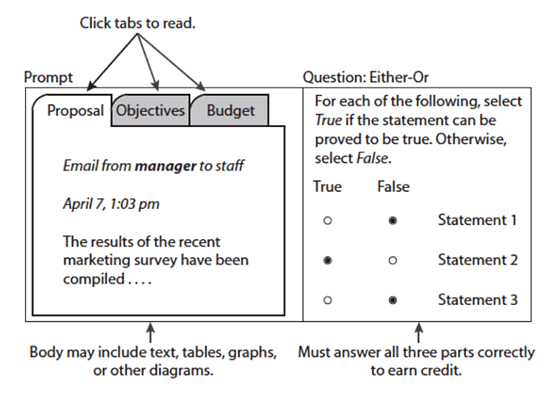
Strategies and Concepts
1. MSR Overview:
- Initially, some test-takers find Multi-Source Reasoning (MSR) in the GMAT Data Insights section a bit scary.
- However, once you figure out a good strategy, it becomes less intimidating.
2. Similarity to Critical Reasoning:
- MSR questions share similarities with the Critical Reasoning section.
- So, preparing for Critical Reasoning also helps you tackle MSR effectively.
3. Question Quantity:
- While the official online guide might show six questions for one dataset, in reality, you usually face three questions in the actual test.
4. Time Management:
- Time management is crucial, so it's important to be efficient in your approach.
5. Tab Navigation:
- Because you can only see one tab at a time, it's essential to quickly scan the tab headings and the information on each tab.
- This helps you make a mental note of where to find specific information when answering questions.
6. Question Types:
- MSR questions encompass various types, including verbal-based, quant-based, and a mix of both.
- Being prepared for a diverse set of questions is key to success.
Key Highlights
Tab 1: Graph with Text
- Graph: Shows a trend of increasing global temperatures over the past century. The data points indicate a steady rise in temperature.
- Text: Accompanies the graph and explains the increase in temperatures due to various factors such as industrialization, greenhouse gas emissions, and human activities. Mentions the impact on climate change, melting ice caps, and rising sea levels.
Tab 2: Table with Text
- Table: Contains information about renewable energy sources and their adoption rates across different countries.
- Text: Explains the table data, highlighting countries leading in renewable energy adoption, reasons for their success, and challenges faced by others in adopting renewable energy. It also mentions the benefits of renewable energy in mitigating climate change.
Sample Question
Tab 1: Greenhouse Gas Emissions
The global warming potential (GWP) of a greenhouse gas is measured in teragrams (or million metric tons) of carbon dioxide (CO2) equivalent (Tg CO, Eq.). In 2010, total U.S. greenhouse gas emissions were 6821.8 Tg CO, Eq. The primary greenhouse gas emitted by human activities in the United States was CO2, representing approximately 83.6% of total greenhouse gas emissions. Overall, from 1990 to 2010, total emissions of CO2, increased by 605.9 Tg CO2, Eq. (11.90%). The largest source of CO2, and of overall greenhouse gas emissions, was fossil fuel combustion.
Within the United States, fossil fuel combustion accounted for 94.4% of CO2, emissions in 2010. Globally, approximately 30,313 Tg of CO2 were added to the atmosphere through the combustion of fossil fuels in 2010, of which the United States accounted for about 18%.
CO2, emissions result both directly from the combustion of fossil fuels for use in one of four end-use sectors (Transportation, Industrial, Residential, and Commercial)—and indirectly from the generation of electricity that is consumed by these sectors.
Tab 2: CO2 from Fossil Fuels

Q1: For each of the following statements, select Yes if it can be reasonably inferred from the given information. Otherwise, select No. 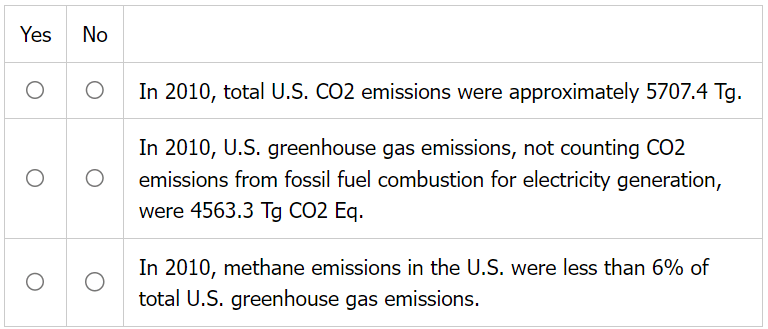
Solution:
Statement: In 2010, total U.S. CO2 emissions were approximately 5707.4 Tg.
In 2010, fossil fuel combustion accounted for 94.4% of CO2 emissions in the United States (Tab 1), and total CO2 emissions from fossil fuel combustion were 5387.8 Tg (Tab 2). Thus, if x were the total CO2 emissions, then: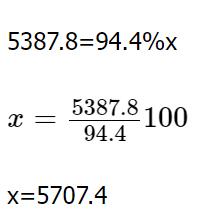
Answer: Yes
Statement: In 2010, U.S. greenhouse gas emissions, not counting CO2 emissions from fossil fuel combustion for electricity generation, were 4563.3 Tg CO2 Eq.
In 2010, total U.S. greenhouse gas emissions were 6,821.8 Tg CO2 Eq. (Tab 1). Total CO2 emissions from fossil fuel combustion for electricity generation equaled the sum of CO2 emissions from fossil fuel combustion for electricity generation for each of the four end-use sectors. This sum is:
(4.5+637.6+843.5+772.9) Tg CO2 Eq. 2258.5 Tg CO1 Eq.
The difference between 6821.8 and 2258.5 is 4563.3, which is the number of Tg CO2 Eq. of U.S. greenhouse gas emissions, not counting CO2 emissions from fossil fuel combustion for electricity generation.
Answer: Yes
Statement: In 2010, methane emissions in the U.S. were less than 6% of total U.S. greenhouse gas emissions.
From Tab 1 you know that fossil fuel combustion accounted for 94.4% of CO2 emissions in 2010, and that CO2 represented approximately 83.6% of total greenhouse gas emissions. Therefore, CO2 emissions from fossil fuel combustion accounted for 83.6% times 94.4% of total greenhouse gas emissions in the United States. That figure is 78.9%.
Answer: No
Q2: For each of the following sectors, select > 5.00% if the sector accounted for more than 5.00% of the world’s CO2 emissions in 2010. Otherwise, select < 5.00%.
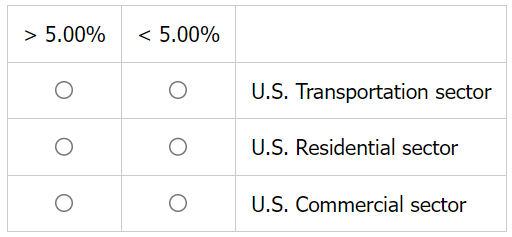
Solution:
Statement: U.S. Transportation sector
From Tab 1 you know that “globally, approximately 30,313 Tg of CO2 were added to the atmosphere through the combustion of fossil fuels in 2010.” Tab 2 gives you the figures for the CO2 emissions from fossil fuel combustion by each enduse sector. Transportation emitted 1750.0 Tg of CO2. If this number is x percent of 30,313, then: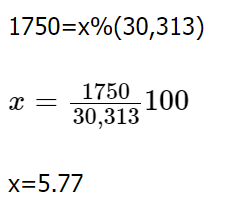
In other words, the U.S. Transportation sector emitted approximately 5.77% of the world’s CO2 emissions through the combustion of fossil fuels in 2010.
Answer: Yes
Statement: U.S. Transportation sector
Follow the same process as in Question 9.1, and you’ll find that the 1183.7 Tg of CO2 that the U.S. Residential sector emitted in 2010 was 3.90% of the world’s CO2 emissions through the combustion of fossil fuels in 2010.
Answer: No
Statement: U.S. Commercial sector
Follow the same process as in Question 9.1, and you’ll find that the 997.1 Tg of CO2 that the U.S. Commercial sector emitted in 2010 was 3.29% of the world’s CO2 emissions through the combustion of fossil fuels in 2010.
Answer: No
Q3: In 2010, CO2 emissions from fossil fuel combustion in the United States accounted for what percent of total greenhouse gas emissions in the United States?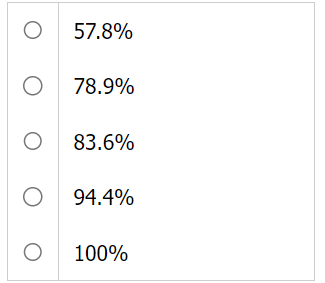
Solution:
From Tab 1 you know that fossil fuel combustion accounted for 94.4% of CO2 emissions in 2010, and that CO2 represented approximately 83.6% of total greenhouse gas emissions. Therefore, CO2 emissions from fossil fuel combustion accounted for 83.6% times 94.4% of total greenhouse gas emissions in the United States. That figure is 78.9%.
Answer: B
|
19 videos|21 docs|16 tests
|
FAQs on Overview with Example: Multi Source Reasoning - Data Insights for GMAT
| 1. What is Multi Source Reasoning on the GMAT? |  |
| 2. How many sources are typically included in Multi Source Reasoning questions? |  |
| 3. What skills are assessed in the Multi Source Reasoning section? |  |
| 4. How can I improve my performance in Multi Source Reasoning on the GMAT? |  |
| 5. Are there any specific strategies I can use for Multi Source Reasoning questions? |  |

|
Explore Courses for GMAT exam
|

|

















